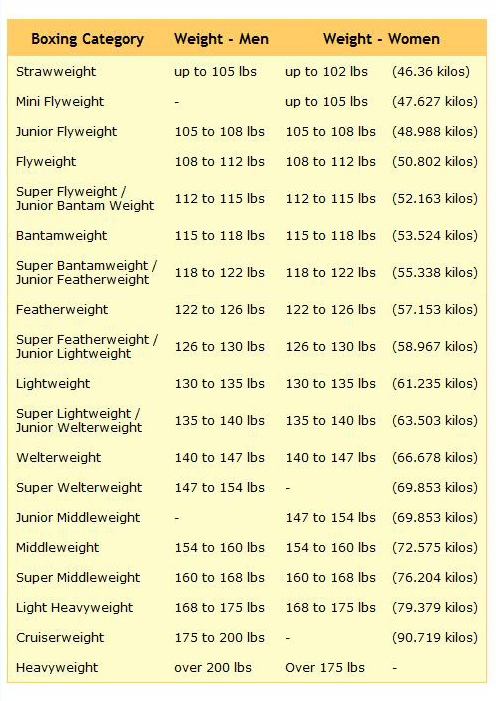What’s happening in the square circle? Here’s a rundown of the basics of boxing.
Boxing Match Format
Ten 3-minute rounds (twelve 3-minute rounds for title fights) with a 1-minute break in between each round.
Unified Rules of Boxing (for title fights)*
- The no three-knockdown rule is in effect
- Only the referee can stop the bout
- If there is an accidental headbutt, it will go to the scorecards to determine the winner, if four rounds of a scheduled 12-rounder have been completed.
Otherwise, the bout will be declared no contest. - A fighter cannot be saved by the bell in any round, including the final round.
- A boxer knocked down shall receive a mandatory eight-count
Other Rules of Boxing (varies from jurisdiction to jurisdiction)*
- You cannot hit below the belt, hold, trip, kick, headbutt, wrestle, bite, spit on, or push your opponent.
- You cannot hit with your head, shoulder, forearm, or elbow.
- You cannot hit with an open glove, the inside of the glove, the wrist, the backhand, or the side of the hand.
- You cannot punch your opponent’s back, or the back of his head or neck (rabbit punch), or on the kidneys (kidney punch).
- You cannot throw a punch while holding on to the ropes to gain leverage.
- You can’t hold your opponent and hit him at the same time, or duck so low that your head is below your opponent’s belt line.
- When the referee breaks you from a clinch, you have to take a full step back; you cannot immediately hit your opponent–that’s called “hitting on the break” and is illegal.
- You cannot spit out your mouthpiece on purpose to get a rest.
- If you score a knockdown of your opponent, you must go to the farthest neutral corner while the referee makes the count.
- If you “floor” your opponent, you cannot hit him when he’s on the canvas.
- A floored boxer has up to ten seconds to get back up on his feet before losing the bout by knockout.
- A boxer who is knocked down cannot be saved by the bell in any round, depending upon the local jurisdiction’s rules.
- A boxer who is hit with an accidental low blow has up to five minutes to recover. If s/he cannot continue after five minutes, s/he is considered knocked out.
- If the foul results in an injury that causes the fight to end immediately, the boxer who committed the foul is disqualified.
- If the foul causes an injury but the bout continues, the referee orders the judges to deduct two points from the boxer who caused the injury.
- If an unintentional foul causes the bout to be stopped immediately, the bout is ruled a “no contest” if four rounds have not been fully completed. (If the bout was scheduled for four rounds, then three rounds must have been completed.) If four rounds have been completed, the judges’ scorecards are tallied and the fighter who is ahead on points is awarded a technical decision. If the scores are even, it will be called a “technical draw.”
- If a boxer is knocked out of the ring, he gets a count of 20 to get back in and on his feet. He cannot be assisted.
- In some jurisdictions the standing eight-count or the three knockdown rule also may be in effect.
- In other jurisdictions, only the referee can stop the bout.
How to Score a Fight*
There are typically three judges for each fight, who calculate points as follows:
If a judge deems that fighter A has out-boxed fighter B in a round, then s/he will score the round 10 points for fighter A, and 9 points for fighter B. If fighter B is knocked down by fighter A, and receives a standing count, then the round is scored 10 points to fighter A and 8 points to fighter B. If the judge decides that neither fighter won a round, then he will score it 10 points to each fighter.
If a fighter is penalized by the referee (such as for multiple low blows), then the referee will turn to each ring-side judge individually and instruct him to deduct a point for that fighter from their score card for that round.
The referee collects the judges’ scorecards after every round and delivers them to the ring-side commissioner. At the end of the fight, the points are totaled to arrive at a decision (win, loss, or draw).
- If all judges score for boxer A then it is a win by unanimous decision (UD) for boxer A
- If two judges score for boxer A and one judge scores a draw then it is a majority decision (MD) win for boxer A
- If two judges score for boxer A and one judge scores for boxer B then it is a split decision (SD) win for boxer A
- If all judges score a draw then it is a draw by unanimous decision (D-UD)
- If two judges score a draw and one judge scores for either boxer then it is a majority draw (D-MD)
Weight Classes**
 * From Boxrec.com
* From Boxrec.com
**From Pub Quiz Help
